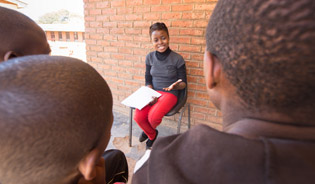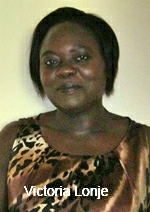BMZ and UNICEF join forces for adolescents’ access to sexual health treatment, care and support in Malawi
The statistics are stark: By the time they are 18, most girls in Malawi already have three children. The country’s fertility rates are among the highest in the region – now even higher than those in neighbouring Mozambique, which suffered fifteen catastrophic years of bitter civil war. “For us it is like a war-torn country, seeing children as young as 11 going into child-bearing,” says Victoria Lonje, a GIZ techincal officer working on sexual reproductive health and rights in Malawi.
Almost half of Malawi’s population is under 15 and although the country has made great progress in bringing down new HIV infection rates – by 70% between 2005 (93,000) and 2013 (28,000) – the national prevalence rate remains stubbornly high (10.3 % in 2014 [1]). Very high rates of teenage pregnancy and school dropout due to early marriage mean that young girls are particularly at risk from HIV and other sexually transmitted infections. In addition, the majority of maternal or neonatal deaths or problems of low birth weights occur in mothers under 22.
Listen to Victoria Lonje on the overlooked needs of adolescents
“Most of our population is young, and yet when the Ministry of Health does its work, they hardly target the adolescents or the young ones. Culturally they don’t really accept it or value the fact that a child under 18 can be sexually active or give birth. But in terms of practice, we see a lot of children dropping out of school – primary and secondary – and then sometimes they drop out even before they are pregnant, just to go and get married. So because of that GIZ thought how can we instill the spirit or the practice of health-seeking behaviour among the adolescents so that when they get into child-bearing age they know how to access the right information and they have the skills to put off unintended pregnancy and also to protect themselves from HIV infection.”
Victoria Lonje says the sexual reproductive health and rights’ needs of adolescents in Malawi have often been woefully overlooked or inadequately addressed.
Narrowing the gap
To address this gap, the Malawi German Health Programme, in collaboration with UNICEF, Banja La Mtsogolo, Baylor College of Medicine Children’s Foundation and Pakachere Social Media, are working together to improve the information and services available to adolescents on sexual and reproductive health and HIV prevention.
Unusual for a bilateral development partnership, the German government decided to channel its financial and technical support for this project through UNICEF rather than the Ministry of Health, recognising that UNICEF would bring youth sensitive expertise to the project.
The initial base-line studies conducted in five districts were so revealing about sexual and reproductive issues affecting young people that six months later it was decided to conduct another study and expand the project to 10 districts, where HIV prevalance amongst young people was equal to or higher than national prevalence of 10.6% in November 2012.
Objectives
Working within and supporting the Ministry of Health’s strategic plan, the BMZ-UNICEF partnership on adolescent reproductive health has three main objectives:
- To ensure that at least 80% of the youth in target districts receive correct information on HIV prevention, teenage pregnancy and sexual reproductive rights, so that they can protect themselves and have relevant skills to reduce their risks and vulnerability to HIV prevention by Sept 2016.
- To reach 80% of vulnerable adolescents in those districts – those who are already sexually active – to prevent them from getting HIV or STIs and ensure they have access to testing and counselling provided through mobile Banja La Mtsogolo and other local services.
- To ensure that 80% of adolescents living with HIV are able to access quality care, treatment and support through the Baylor clinic, which works with 10 to 19 year olds, or through local health facilities
How will these objectives be achieved?
On behalf of BMZ, GIZ’s role is to provide technical support, and Victoria Lonje works with a team which includes specialists in child protection, a nurse for youth friendly services and community outreach counsellors who address cultural barriers. She has regular co-ordination meetings with her counterparts in UNICEF and the Ministry of Health and district level and every six months travels with her team to provide technical support to the 10 districts and district health offices.

Vans with music, “edutainment” and lively social media campaigns prepare the way for the outreach teams going to the districts, so that young people are mobilised to attend mobile HIV testing and counselling. Radio and TV campaigns also raise awareness of the issues, and a Help Line has been set up so that adolescents can pick up a phone any time of the day and ask a question or present a problem. Where these calls reveal sexual abuse has taken place, the YONECO child helpline staff links with the victim support unit, which is managed by community police. The Victims Support Unit is supposed to follow up and address the child protection issues but often falls short of doing so due to various limitations, capacity challenges being prominent.
What has been done so far
The collaboration between UNICEF, GIZ, BLM, Pakachere and Baylor clinic led to the following results in 2013-14:
- Twenty one Teen Clubs which meet monthly have been established in 10 districts;
- More than 1,100 young Malawians living with HIV have joined these Teen Clubs;
- 7,754 adolescents received family planning services;
- 33,000 young people 10-19 years received HIV testing and counselling;
- 1,479 adolescents received treatment for sexually transmitted infections, and 136,559 received condoms.
Twenty one year old Mphatso is one young Malawian who has benefitted from these interventions. In 2007 when she was only 14, she discovered that she was HIV positive as a result of being infected at birth. Her mother died of AIDS, and Jospehine now lives with her father and step mother in the capital Lilongwe, where she attends the Baylor clinic for antiretriviral treatment, counselling and support. She’s also an active member of the Teen Club there.
Listen to audio clip of Mphatso on the Teen Club
“At Baylor we have a social group for adolescents living with HIV called Teen Club. I joined the club and that’s where I also met a lot of teens who were also living with HIV. It meets once a month. We learn a lot about disclosure and sexual reproductive health, adherence and how I can protect myself from getting more infections and transmitting HIV to other people ….It has helped me to live positively with the virus and to be confident in myself.”
Mphatso has just finished school and her ambition now is to become a doctor.
For Victoria Lonje, one of the most exciting results of these interventions has been the dramatic reduction in school drop outs in some areas. In Thyolo district for example, she says not one child has dropped out of school from May 2013 until September 2014.
 Listen to audio clip of Victoria Lonje on reduction in school drop outs.
Listen to audio clip of Victoria Lonje on reduction in school drop outs.
“This is the longest stretch we have gone without a child dropping out of school, and by their own standards, they are very excited. After working for nine months, the results started showing. The children who were maybe forced to go into early marriage and drop our of school because of pregnancy are also now motivated to being change agents, because they can now go into schools and say don’t do what I did… this is what I am experiencing as a result of my decision. So the whole district is motivated and you feel it when you go there that change is happening.”
She attributes this rapid success to the close collaboration that now exists between traditional chiefs, the district health officer and district education manager who are working very closely together to sensitise and mobilise the area, and to provide co-ordinated prevention, treatment and care services.
These local officials now meet regularly, and as a result, this has led to better information and data, a better understanding and greater immediacy, says Victoria: “The statistics now have a face on them”.
 Listen to audio clip of Victoria Lonje on putting a human face to statistics.
Listen to audio clip of Victoria Lonje on putting a human face to statistics.
“At first when they record that so many children dropped out of Standard 7 or standard 8, it was a done deal – ok, so 46 children dropped out, big deal. But then when they sat in the same meeting as the district health officer they realise that some of those children don’t even make it in life because they die with that pregnancy. So it put a human face on the startistics that they deal with. Because the education manager would say – ah! That’s my Standard six child that died in childbirth… Oh my God I wish I had followed up. That child was intelligent… so those emotions made the district education manager work slightly harder at an individual human level.”
Remaining challenges
The project is only just over half way through, and although much has been achieved, many challenges of course remain. Available district based data remains inconsistent and unreliable, and financial weaknesses and issues of accountability have hindered progress in some areas. Rapid staff turnover of health professionals trained in youth friendly service delivery lowers the quality of services, and a recent government directive reducing official allowances, means that fewer officials turn up for meetings.
The biggest challenge of all, says Victoria Lonje is sustainability. “We saw that in the four districts where we didn’t go in with the resources, hardly anything was moving, so we were asking ourselves what will happen two years down the road when GIZ resources are not there? Is this thing going to have lasting impact?”
Behaviour change is often a slow process and poverty, she says, is another big challenge facing many young people, whose parents often can’t afford to feed them. Her dream is that one day Malawi will have a social protection programme that will provide a safety net for children, so that they aren’t forced into transactional sex just for a packet of sugar.
The project will be funded until September 2016, when there will be an independent evaluation. The results so far suggest the interventions have had a big impact. Victoria hopes the lessons can be used elsewhere, and is committed to sharing them at the regional synposium on adolescent sexual and reproductive health and rights to be held in Zambia in December.
Victoria is clearly excited by her work with young people like Mphatso, and by the results achieved so far by GIZ’s partnership with UNICEF. But there are other benefits too, she says: “The high energy level of the adolescents is so motivating that they are keeping me young at heart.”
By Ruth Evans
[1] Malawi German Health Programme fact sheet “Cross-cutting Issues: Strengthening the provision of HIV treatment, care and support for adolescents and adults.” quoted from NAC 2014 Joint Annual Review report.

